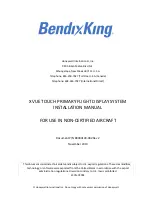
CHAPTER 4
REFERENCE GUIDE
EFD1000H PFD Pilot’s Guide
Page 4-52
091-00012-001 REV C
WARNING
GPS Steering is a powerful automation tool that
can substantially reduce pilot workload. However,
using GPSS safely and effectively requires a thorough
understanding of your specific aircraft installation and
the interaction between the PFD, your GPS navigator,
and your autopilot. Pilot actions required to use
GPSS safely can vary significantly depending on the
autopilot and GPS navigator installed, especially when
used on instrument approaches, especially those with
vertical guidance.
It is imperative that pilots new to GPSS gain experience
with it in VFR conditions and, ideally, get dual
instruction from a CFII who thoroughly understands
GPSS and the autopilot and GPS navigator in your
airplane before using GPSS on instrument procedures
in IMC.
4.7.1. GPS Steering (GPSS)
1
GPS Steering represents a modern approach to flying between flight plan waypoints,
and offers many advantages of over traditional methods of flying direct course lines
between waypoints.
With traditional point-to-point navigation, the autopilot is provided with desired course
and cross-track deviation information associated with the current flight leg. From there,
it will maneuver the aircraft to center the needle and track the desired course. The
autopilot does not anticipate upcoming course changes, nor can it fly curved flight
paths without pilot assistance, and it has to recompute wind corrections following each
course change. Upon reaching a waypoint, the pilot must set the course for the next
leg (unless AUTOCRS is enabled,
see
Section 4.4.6. Auto Course
), and the autopilot will
then intercept and track that leg. In this type of operation, the CDI must always be set to
the desired course.
With GPSS, the PFD can unlock the GPS Steering capability already available in many
models of general aviation GPS navigators. With GPSS, the navigator continuously
computes the desired bank angle to track the GPS flight plan, and outputs that
information over a digital data bus. The GPS Steering command anticipates upcoming
turns; this includes the turn rate and turn initiation point required to roll out centered
on the next leg.
Some GPS navigators, such as the Garmin 4xx/5xxW series of WAAS navigators, even
provide GPS Steering commands for complex procedures, such as DME arcs, holding
patterns, and procedure turns allowing the autopilot to fly these maneuvers without
pilot intervention. Check with your GPS manufacturer to see if your GPS supports these
capabilities.
1. Not available with the Pilot PFD

































